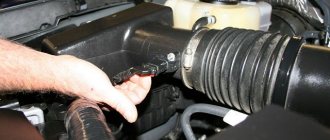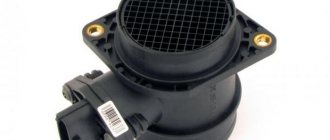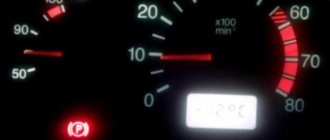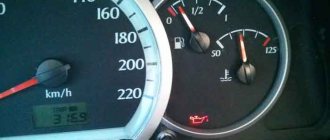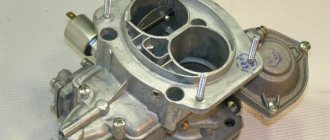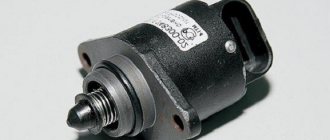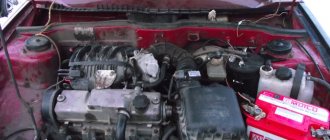- Check for air leaks in the intake, the operating parameters of the coolant temperature sensor (use a scanner to check what temperature the ECU sees), the problem may also be in the wiring or connector of the IAC, TPS, it is also worth checking the injector spray and fuel pressure.
- There is definitely an air leak. Check the vacuum hoses of the intake manifold; over time, they crack due to temperature or simply jump off the fitting. If you removed the remote control, then dirt could get under the gasket. In general, when the throttle assembly is removed, a new gasket must be installed each time (with an old gasket, unaccounted air can be sucked in).
VAZ 2114 injector idle speed floats
If your VAZ 2114 injector idle speed is floating, then you should definitely read the following article, in which we will talk about the main reasons for this behavior of your engine, as well as provide brief recommendations for correcting the situation.
Reasons why idle speed fluctuates on injection VAZ 2114
In total, there are 7 main reasons why the idle speed of a VAZ 2114 injection engine may float.
Reason 1:
mass air flow sensor. To check, you must measure the voltage between the green and yellow wires, it should be in the range from 0.99 to 1.00. If this is not the case, change the sensor.
Important!
To check, set the multimeter to the 20 volt position.
Reason 2:
idle speed controller. Unfortunately, there is no exact recipe for determining whether it is faulty, just change it and see if the problem goes away.
Reason 3:
crankshaft sensor. To check it, set it to a position where the maximum value is 200 mV. After this, connect its leads to a multimeter and run a screwdriver over the core. You should see power surges. If they are not there, change the crankshaft sensor.
Reason 4:
speed sensor wiring. The check is very simple: visual inspection for obvious damage, as well as cleaning the contacts if even minimal oxidation is detected.
Reason 5:
throttle position sensor. Everything is very simple here, you need to clean the throttle assembly, since the sensor itself is unlikely to be broken. You can see and read how to do this in our article on how to clean the throttle assembly.
Reason 6:
spark plug. You need to unscrew the spark plugs and check them for carbon deposits and other contaminants. If this is found, it is best to replace them; cleaning is too short-term a solution.
Reason 7:
idle speed solenoid valve. To check it, you must disconnect the power from it, then start the car and touch the power wire to the contact from which it was disconnected. You should hear a clear click; if there is none, we replace the corresponding machine component.
What to do if nothing was found?
If none of the reasons described above were found, then we have not the most joyful news for you - you will have to contact a car service station, since all other components that cause the idle speed of the VAZ 2114 injector to float can be checked and corrected only on special equipment and exclusively by experienced craftsmen.
Checking status
If you have a tester for checking, the procedure is simplified. But you can diagnose performance without the help of special analyzers. Here you cannot do without the help of a friend, colleague, neighbor or just an acquaintance. You need to connect the connector to the removed sensor. Gently place your finger on the tapered needle and its tip. At the same time, you need to remember that you cannot put pressure on the needle. After this, please start the car (turn on the ignition). The finger should feel slight vibrations (shocks). This indicates the operating condition of the regulator.
Idle speed sensor VAZ 2114
Next, we inspect the IAC itself to identify its contamination. It is necessary to clean it, as this will increase its service life and affect the engine speed and its operation. It is easy to clean. We take a special cleaner designed for the carburetor. It is inexpensive, sold in any auto store, as well as in many hypermarkets in the car department. Dip a cotton swab into the liquid and carefully rinse all contacts.
We also fill the rod, spring and cone needle with cleaner and use an old toothbrush to remove all dirt. To improve performance, we also clean the throttle valve. Before returning the IAC to its place, it is better to also clean the valve and its seat, as well as the entire surface area on which the O-ring is attached. We coat the sealing ring itself with engine oil and put everything back in place in reverse order.
VAZ 2114 idle speed fluctuates: causes of malfunction and ways to solve the problem
The five-door hatchback VAZ 2114 is a restyled model of the famous “nine”, which rolled off the assembly line of the car plant from 2003 to 2013. At various times, the manufacturer installed on the car power plants with carburetor or distributed fuel injection (injector) of its own making, and since 2007 the car has been equipped with an electronic engine control system. Note that all these engines have one common and very significant drawback - when they switch to idle mode, their crankshaft speed suddenly begins to “float”.
Idle mode
Idle speed is the operating mode of a car engine with the gear in neutral. It is characterized by minimal engine load and low fuel consumption.
Idle mode is used:
- for delivering motor oil from the engine crankcase to friction units after a long period of parking the vehicle;
- to warm up the power unit in the cold season;
- in cases where turning off the motor is impossible or undesirable.
During normal engine operation, the crankshaft speed is idling at 2000 rpm. gradually decrease to 800, then maintaining at this level. However, it also happens that the power plant, when switching to this mode, operates unstably - it randomly changes the speed in the range of 500–1500 rpm, “chokes” and stalls. This tells us: a failure has occurred in the engine control system, the causes of which must be diagnosed and eliminated as soon as possible.
The movement of the arrow of the device shows the change in the number of engine revolutions
Determining the specific cause of the malfunction is not easy, but it cannot be ignored - this can lead to critical engine failure and the need for expensive repair work. In addition, driving a car with an engine that is unstable at idle speed distracts the driver's attention. He has to constantly monitor changes in the speed and keep his foot on the gas pedal, preventing the engine from stalling when braking or stopping briefly.
Causes of malfunction
Among the reasons leading to improper engine operation in idle mode are problems with sensors that transmit information to the electronic control unit.
These include sensor malfunctions:
- idle speed controller (IAC);
- mass air flow (MAF);
- crankshaft position (CPCV);
- throttle valve position;
- vehicle speed (VSA).
The appearance of floating crankshaft speeds also causes:
- malfunction of the idle speed solenoid valve;
- dirty air filter and spark plugs;
- damage to high-voltage wires;
- wear of gaskets and plugs at the junction of the intake manifold with the cylinders;
- malfunction of the EGR valve, which regulates exhaust gas emissions.
Repair rules
The idle speed regulator is a special executive function that is necessary for the engine to operate in normal mode. If it turns out to be faulty, the indicator that indicates this fault will not light up. This means that identifying the problem can be quite simple. All that remains is to eliminate it as soon as possible.
The regulator is a stepper motor that makes it possible to guarantee a certain level of air flow that bypasses the closed damper.
The flow level is set by the car's electronics. Such a complex system allows the motor to operate as evenly and stably as possible. Also, the electronic system of the machine performs the function of protecting against external factors, because the engine operates normally under almost any circumstances.
Methods for eliminating floating engine speeds
When starting to find and eliminate the reasons that cause unstable operation of the engine in idle mode, you first need to check:
- Condition of the air filter and spark plugs. If they become critically dirty, they need to be replaced.
- Integrity of insulation of high-voltage wires. If damage is found, they must be replaced.
It is recommended to make sure that there is no suction at the junction of the intake manifold with the engine cylinders. To do this, with the engine running, you need to sequentially spray all joints at the joints with carburetor cleaner or other flammable liquid. If atmospheric air enters there, the car engine jerks sharply, which is why, if a damaged gasket or plug is detected, the element is replaced. Let's consider the remaining elements of the car, the malfunction of which can affect the smooth operation of the VAZ 2114 engine in idle mode.
Checking the tightness of the intake manifold (video guide)
Let's consider the remaining elements of the car, the malfunction of which can affect the smooth operation of the VAZ 2114 engine in idle mode.
Reduced compression in the combustion chamber
The car engine must be clean and dry. Regular care of its surface will help to detect various leaks of working fluids in time, go to the workshop on time and prevent even greater expenses. This is especially useful for early detection of oil leaks. There can be several reasons for an oil leak. These are used oil seals, cover and pan gaskets, spark plug wells and much more. But we are seeing decreased compression, which is often due to a damaged head gasket (cylinder head). There is a strong leakage of oil on the surface of the engine, which is pushed out of the cylinder block under pressure.
Destruction of the gasket leads to unstable engine operation and can lead to more dangerous consequences, such as coolant getting into the oil, disruption of the block geometry, and even water hammer.
By promptly replacing a damaged gasket, you can protect your vehicle from serious damage and keep it clean and dry.
Is the EGR system on the injector working?
"Floating" speed can be caused by jamming of the exhaust gas recirculation (EGR) valve, which is installed in the exhaust manifold. It is necessary to periodically remove dirt from the valve seat and its seat using a carburetor cleaning aerosol, avoiding liquid getting on the sensor diaphragm.
Keep the valve seat clean
Attention! If cleaning the unit does not give a positive result, the device must be replaced.
Is the idle air control valve working correctly?
The IAC is checked by measuring the electrical resistance at the contacts - to diagnose the device you will need a tester (multimeter) set to the “ohmmeter” operating mode. To check the details:
- Let's turn off the ignition.
- Disconnect the connection block.
- Let's measure the resistance on contacts A - B and C - D of the device. The optimal readings of the device vary from 40 to 80 ohms.
- Let's repeat the measurements with contacts B - C and A - D. In this case, the multimeter should show “infinity” or an open circuit.
Any violation of the normal resistance values means a malfunction of the regulator. IAC failure is a common cause of floating engine speed at idle, and if a malfunction is detected, the device must be replaced. Before you begin dismantling the part, you must disconnect the negative wire from the battery. After installation, the new IAC is calibrated - the removed terminal is returned to its place, the ignition is turned on and after 5-10 seconds (there is no need to start the engine).
IAC failure is a common cause of floating engine speeds.
Attention! If the battery is not disconnected before dismantling the device, the electronic control unit will not calibrate the IAC.
How to measure generator voltage?
In order to notice changes in the readings on your car’s generator in time, you need to learn how to measure them.
There are two ways. The first one is quite easy, but not very accurate. You can view the voltage readings on the on-board computer. However, they cannot be called reliable, since they are often underestimated. Or the voltage may jump from the load. And this does not always mean a malfunction. The reason may be that some consumer is too powerful or is not connected as needed. Or maybe it’s all about the error of the device.
The second method requires more time and effort, but it allows you to determine the data more accurately. To perform this you will need a multimeter and an assistant.
You need to do the following:
- Turn on the ignition and wait until all warning lights on the instrument panel light up normally.
- Start the car and make sure the battery light goes out. If not, then you need to look for a breakdown - the generator or battery may be faulty, or there may be problems with the wiring.
- The car must warm up to operating temperature, and all existing electrical consumers must be turned on.
- The multimeter is set to voltmeter mode.
- An assistant is involved in the work: he must maintain the engine speed within 3500.
- Connect the multimeter to the battery.
- Take measurements. Normally, a reading of 13-13.2 V or a little more should appear on the multimeter. If the number is lower, this is a sign of a faulty generator or battery.
The same sequence of actions should be carried out with switched off consumers. If the generator is working properly, the multimeter will show approximately 14.5-14.7 V.
When connecting a multimeter to the generator terminals, the readings should be within 14-14.3 V. When the assistant increases the engine speed, the voltage should change by no more than 0.5 V. If its value fluctuates greatly, this is a sign of a malfunction in the device.
Serviceability of the mass air flow sensor
To diagnose the mass air flow sensor, you need to switch the tester operating mode to “voltmeter” (20 V). We check the part by following these steps:
- Let's turn off the engine and turn on the ignition.
- Let's measure the voltage at the connection connector between the contacts of the green and yellow wires. The multimeter reading should be in the range of 0.99 - 1.02 V.
The device can be cleaned by “blowing” with a carburetor cleaning aerosol
Attention! The device can be dismantled and cleaned using a carburetor aerosol, but this does not always help. In the event of a critical component failure, it will have to be replaced.
Video: Checking the mass air flow sensor
Cleanliness of the damper assembly
The throttle valve assembly is diagnosed by visual inspection for contamination. Clean the part with cotton swabs and a toothbrush moistened with a cleaning solution. For ease of work, the device is dismantled. After cleaning, it is recommended to blow out all channels and pipes of the unit with compressed air using a tire inflator.
To clean the part, it must be dismantled
Attention! It is recommended that the channel responsible for removing gases from the crankcase be completely filled with a cleaning solution before purging - the diameter of the element is very small and there is no other way to access it.
Video: How to clean the throttle body
Is it possible to diagnose DPKV and DSA?
A breakdown of the DPKV and DSA (Hall sensor) is indicated by the Check Engine indicator that lights up on the car’s dashboard. Testing these devices is only possible using special instruments (oscilloscopes). You can first check the integrity of the wiring; if it is broken, the damage should be repaired.
- The DPKV sensor is installed on a bracket located in close proximity to the generator drive pulley.
- The DSA is located on the speedometer drive mechanism of the gearbox.
For a more detailed introduction to methods for detecting faults associated with engine malfunction in idle mode, it is recommended to watch the following video.
Video: Computer diagnostics of VAZ 2114 idle problems
So, the main steps to rid the car of floating engine speed at idle are considered. Remember: if performing these operations yourself does not lead to a positive result, you will have to contact a service station with the necessary diagnostic equipment and qualified repairmen.
Sources
- vazzz.ru/vaz-2114-na-goryachuyu-plavayut-oboroty/
- vazgarage.ru/vaz2115/dvigatel2115/899-plavayut-oboroty-holostogo-hoda-vaz-2114-inzhektor.html
- zen.yandex.ru/media/id/5dc241c434808200b20fb268/plavaiut-oboroty-v-dvigateleustali-ot-problemy-poprobuite-moi-sovetv-svoe-vremia-on-mne-pomog-na-vaz2115-5e184d5f433ecc00ae3ff1f6
- drive2.ru/l/5125037/
- ladaautos.ru/vaz-2115/pochemu-plavayut-oboroty-na-vaz-2115-inzhektor.html
What to do if cars with automatic transmission stall?
If your vehicle has an automatic transmission, then the problem should be found in the electrical supply. If you abruptly switch from one gear to another, or while switching gears while braking, the settings may be distorted, and the on-board computer will receive a signal to turn off the engine.
Also, models with automatic transmission may stall due to malfunctions of the hydrodynamic transformers of the gearbox. This problem mainly manifests itself during acceleration and requires urgent intervention from car service specialists.
Sources
- vaz-russia.com/vse-ob/pochemu-glohnet-mashina-na-hodu.html
- o-ladagranta.ru/vaz-2115-glohnet-na-holostyh-oborotah-prichina/
- nadomkrat.ru/innteresnoe/pochemu-mashina-vaz-glohnet-na-holostyh-oborotah
